According provided by lens NIKON ED AF-S NIKKOR 28-300mm 1: 3.5-5.6G SWM VR IF Aspherical many thanks to Alexander Dundanov.
Nikon has had a five-year hiatus in superzoom lenses for full frame cameras. The last model, before Nikon ED AF-S NIKKOR 28-300mm 1: 3.5-5.6G SWM VR IF Aspherical from this review, was not very successful Nikon ED AF Nikkor 28-200mm 1: 3.5-5.6G IF Aspherical, which was produced for only two years, from 2003 to 2005. And so, in August 2010, Nikon introduced the Nikon 28-300 / 3.5-5.6G lens, which became the record holder - it has the largest zoom ratio among all lenses for full-frame cameras in the series Nikon FX. The zoom ratio is as much as 10.71 X!
For reference: Canon released its monster-like CANON ZOOM LENS EF 28-300mm 1: 3.5-5.6L IS USM ULTRASONIC (with the same tenfold zoom) back in the summer of 2004. But Tamron managed to introduce his first AF 28-300mm F / 3.5-6.3 LD Aspherical IF MACRO 185D back in 1999!
Main technical characteristics of Nikon ED AF-S NIKKOR 28-300mm 1: 3.5-5.6G SWM VR IF Aspherical:
| Review Instance Name | Nikon ED AF-S NIKKOR 28-300mm 1: 3.5-5.6G SWM VR IF Aspherical 52070705 |
| Basic properties |
|
| Front Filter Diameter | 77 mm, plastic thread for filters |
| Focal length | 28-300 mm EGF for Nikon DX cameras is 42-450 mm (!) |
| Zoom ratio | 10.71 x |
| Designed by | for Nikon FX full-frame digital cameras |
| Number of aperture blades | 9 pieces |
| Tags | focusing distance in meters and feet, focal lengths for 28, 35, 50, 70, 105, 200 and 300 mm, bayonet mount tag and lens hood mounts |
| Diaphragm | from F/3.5@28mm to F / 22 @ 28mm and from F/5.6@300mm to F / 36 @ 30mm (on official website indicatedthat the aperture closes to F / 38 @ 300mm, but when checking on cameras Nikon D80, D700 install F / 38 was impossible) |
| MDF | 0.5 m, maximal magnification factor 1: 3.1 |
| The weight | 800 g |
| Optical design | 19 elements in 14 groups, 3 aspherical elements (aspherical elements are shown in blue in the optical diagram) and 2 ED elements (in yellow in the optical diagram). The image is clickable. |
| Lens hood | Nikon HB-50 |
| Manufacturer country | MADE IN THAILAND |
| Period | From August 2010 to the present day (at least until 2017) |
| Cost: |
Although Nikon waited a long time for the release of such a lens, it did it - it did it. Excluding minor flaws, the lens is pretty good.
Assembly
Production of Nikon 28-300 / 3.5-5.6G established in Thailand. To the touch it is pleasant and weighty, its weight is as much as 800 grams, and it surprises me who needs such a heavy lens with such a low aperture... The Nikon 28-300 / 3.5-5.6G uses large professional 77mm filters (superzoom has to be big!).
The focusing ring is plastic, and the zoom ring is rubberized. Nikon 28-300 / 3.5-5.6G has metal bayonet. The retractable lens trunk has two sections. The first (the one closer to the bayonet) is plastic, the second is metal. The sections are strong enough to the touch, without any backlashes.
There is a bayonet mount mark on the body and a mark for quick installation of the hood. The lens uses a plastic hood HB-50, which is fixed in special grooves located near the front lens of the lens. The hood can be installed in the opposite direction for transportation. In this position, access to the zoom ring is practically not lost. Typically Nikon Nikkor zoom lenses have focus and zoom rings in reverse order - the zoom ring is closer to the mount and the focus ring is closer to the front lens.
The Nikon 28-300 / 3.5-5.6G comes with a soft case CL-1120, and the lens itself comes in a small cardboard box with a characteristic Nikon coloring.
'LOCK 28' button
Frame (trunk) for Nikon 28-300 / 3.5-5.6G spontaneously changes its size under its own weight (perhaps this only begins with time). For example, when the camera is tilted down, the lens trunk lengthens spontaneously (the focal length increases). To prevent such an unpleasant nuance from happening, there is a 'LOCK 28' (the so-called 'lock') focal length lock button on the lens barrel, which firmly locks the focal length at 28 mm.
To fix the trunk of the lens, you must first set the 28 mm focal length.
The button is conveniently located under the thumb of the left hand, so the lens can be quickly and comfortably removed from the lock before shooting.
Also, note that while changing the focal length, the rear lens moves in the middle of the lens body like a pump - it draws in and pushes out air. This behavior of the rear lens is called 'effect' of a vacuum cleaner, which can increase the amount of dust that accumulates in the camera.
The effect of the vacuum cleaner on the Nikon 28-300 / 3.5-5.6G is quite noticeable. At first, I even wanted to shoot a video where Nikon 28-300 / 3.5-5.6G could blow soap bubbles using this effect, but, unfortunately (or fortunately), the lens could not blow soap bubbles) :.
Diaphragm
Diaphragm the lens consists of 9 rounded petalswhich form a fairly even hole. It's nice that Nikon did not stint on nine petals. Aperture range is available from F / 3.5-5.6 to F / 22-F / 36.
There are marks with a focal length on the zoom ring, the following is a list with the minimum numbers F available for these marks:
- 28 mm - F / 3.5
- 35 mm - F / 4.0
- 50 mm - F / 4.5
- 70 mm - F / 5.0
- 105 mm - F / 5.3
- 200 mm - F / 5.6
- 300 mm - F / 5.6
It would be much better if aperture fell more linearly with increasing focal length from 28 to 300 mm. Apparently she was sacrificed for a large zoom ratio.
Stabilizer
The Nikon 28-300 / 3.5-5.6G has a VR stabilizer (actually VR II - the second generation), which, according to the instructions, can compensate 3 stops by shutter speed (sometimes they write 'up to 4 stops'). In values excerpts this means you can shoot at shutter speeds 8 times slower than a lens without a stabilizer would require. But you just need to remember that the stabilizer is not a panacea, it can only sometimes help to achieve a sharp shot.
В Nikon 28-300 / 3.5-5.6G lens instructions 3 stops are indicated (measurements by Nikon), and on the official website 3.5 feet (measured by CIPA). In any case, the stabilizer works well.
To turn on / off the stabilizer on the lens there is a button 'VR ON / OFF'. The stabilizer can operate in two modes: 'Normal' and 'Active'.
'Normal' mode designed for most scenes and avoids movement when camera shake. Theoretically, the 'Normal' mode can still track the movement of the camera to create panoramas.
Active Mode most suitable for shooting when the camera can not only shake, but also move in different directions. Most often, it is advised to use this mode when shooting in motion.
When working with the lens, I noticed that the stabilizer works much better in the 'Active' position, which is why I recommend leaving it in this position. The gimbal itself works well. I was able to take pictures without blur and great effort at 300 mm focal length and 1/40 second (example).
Focusing
Nikon 28-300 / 3.5-5.6G focuses quite quietly thanks to 'SWM'-motor (Silent Wbird Motor - quiet wave motor) and refers to the lens'AF S'type (with built-in motor focusing), and therefore it will automatically focus on any Nikon digital SLR camera.
Auto focus speed is average, but sufficient for most tasks. On my cameras Nikon D80, D700 lack of tenacity of focus, especially in the range of 100-300 mm focal length. In this range, the lens often loses the subject and re-focuses. This is most likely due to low aperture lens, since F / 5.6 is the limit for focus sensors my cameras. With other cameras, the lens may behave differently.
During focusing, the front and rear lenses remain stationary, as the lens uses internal focusthat is indicated on the case by the letters'IF'-'Iinternal Focus' - 'Inner Focus'. The front lens does not rotate while zooming. It is possible to use any filters without problems.
The minimum focusing distance is only 50 cm, while you can shoot Macro with 1: 3.1 magnification (i.e., the subject will be projected onto the camera’s matrix very large). This is a very good magnification factor for this kind of lens. The lens hood does not interfere with work when shooting small items. Nikon 28-300 / 3.5-5.6G has a window with a scale of distances in meters and feet. IPIG scale no.
Nikon 28-300 / 3.5-5.6G suffers greatly from the 'Focus Breathing' effect - changing the angle of view while focusing. At a 300 mm focal length, when focusing towards the MDF, the angle of view expands, and on the MDF it becomes equal to the angle of view of a lens with an effective focal length of about 150 mm.
On the lens housing you can find focus switch 'M / A - M'. In the 'M / A' position, auto focus works with constant manual focus priority. The 'M / A' mode is very convenient and useful - for manual focusing or focus correction, you do not need to additionally switch the lens to the 'M' mode.
Nuance: at work, I noticed one little thing that does not affect the work with the lens very well. The bottom line is this - to slightly shift the focus ring, you need to 'tear it off'. At the same time, smooth focusing is lost, since after such a “jerk” the ring flies over the desired value. The effort is not so big, but such a “slightly twitchy” method of focusing is very annoying during manual focusing. There is a similar effect on many other lenses, most pronounced on Nikon ED AF-S Nikkor 24-120mm 1: 3.5-5.6G SWM VR IF Aspherical... And even worse - the focus ring has small lag, which is most pronounced when the rotation starts in the opposite direction. During automatic focusing, these drawbacks do not appear, but during manual focusing, they are very unnerving.
Compatibility and Features
Nikon 28-300 / 3.5-5.6G is designed primarily for Nikon FX full-frame cameras, but no one forbids its use on Nikon DX cameras, where it EGF is 42-450 mm. We can say that Nikon 28-300 / 3.5-5.6G is a full-frame analogue of cropped Nikon DX AF-S Nikkor 18-200mm 1: 3.5-5.6GII ED SWM VR IF Aspherical.
Nikon 28-300 / 3.5-5.6G will work without problems on any Nikon digital SLR camera.
Image quality
Surprisingly, as for a superzoom, Nikon 28-300 / 3.5-5.6G shows very good image quality. First of all, good sharpness in the center of the frame at any focal length is surprising. The lens is resistant to flare, it is rather difficult to catch glare, but it is possible. Like most 'dark' zoom lenses, the Nikon 28-300 / 3.5-5.6G has good contrast.
Among the shortcomings, I would single out the usual problems for this kind of lenses - strong distortion, especially at 28 mm and chromatic aberration, as well as low sharpness at the edges of the frame. Modern cameras can automatically correct distortion and HA... The Nikon 28-300 / 3.5-5.6G drawing (if it can be called a drawing) fully corresponds to that of a dark super-zoom. If we ignore a trifle, the Nikon 28-300 / 3.5-5.6G produces not excellent, but good picture.
You can download RAW source files at this link (77 files in the .'NEF 'format, 1 GB). All photos were shot using protective filter Kenko UV 77mm JAPAN (part of the highlights in the photo from this filter). Photos in previews with Nikon D80 - on-camera JPEG, with Nikon D700 - developed RAW.
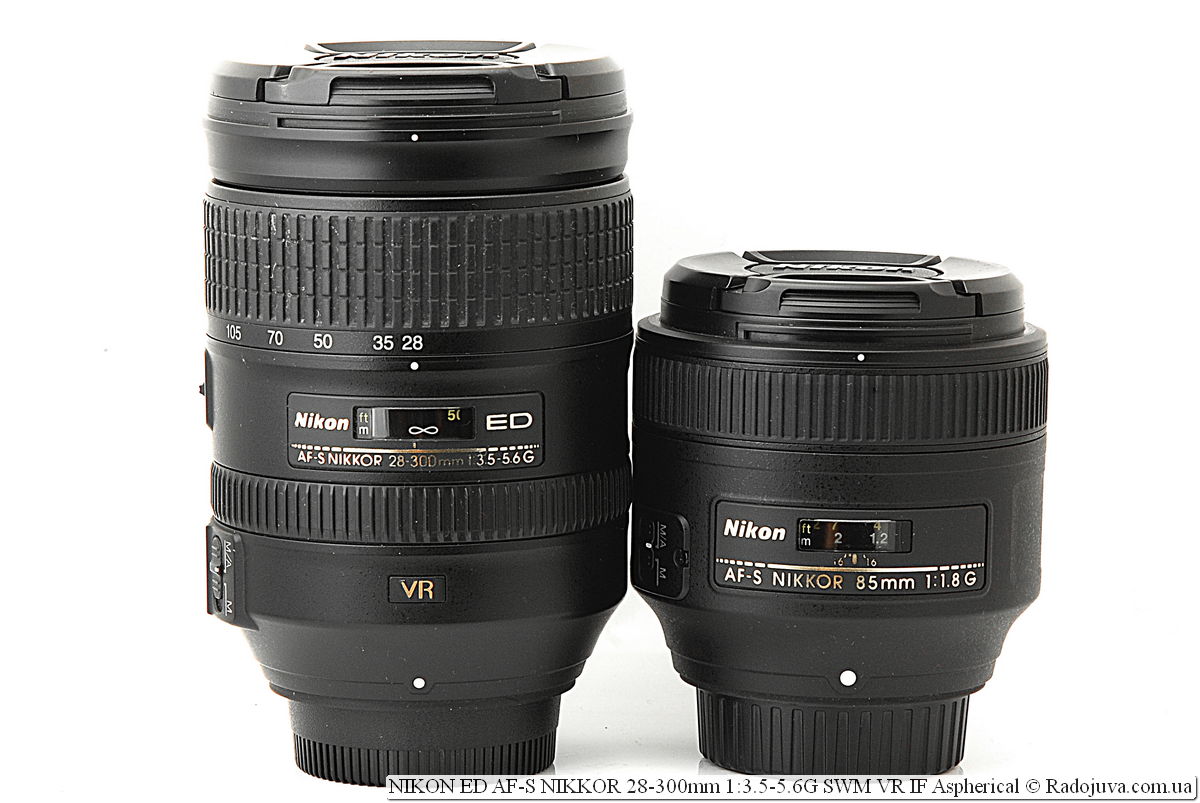
Nikon ED AF-S NIKKOR 28-300mm 1: 3.5-5.6G SWM VR IF Aspherical rams and Nikon AF-S Nikkor 85mm 1: 1.8G IF SWM
My experience
I used the lens for about a week, even took it to a wedding, where I tried to shoot a report with it. As a result, it turned out that for reporting shooting he lacks neither speed nor tenacity of focus.
After Tamron AF 28-300mm 1: 3.5-6.3 [IF] Macro A20 Aspherical LD XR DI VC Nikon 28-300 / 3.5-5.6G seems to be just a fairy tale. But still, the Nikon 28-300 / 3.5-5.6G is too heavy to be a versatile everyday lens. It’s better to have a lighter and more compact whale. Nikon AF-S Nikkor 24-85mm 1: 3.5-4.5G ED VR SWM IF Asphericalthan to rush with this monster.
It is often said that the Nikon 28-300 / 3.5-5.6G can be an excellent lens for traveling, but it seems to me that few amateur photographers like to constantly carry a heavy full-frame camera with them, and even an almost kilogram lens.
For almost the same price of one Nikon 28-300 / 3.5-5.6G, you can take a good Nikon 70-300mm 1: 4.5-5.6G ED AF-S VR along with good Nikon AF-S Nikkor 24-85mm 1: 3.5-4.5G ED VR SWM IF Aspherical. Of course, for those who are crazy about superzoom, the Nikon 28-300 / 3.5-5.6G will be sweeter than any other alternatives.
The offer to use Nikon 28-300 / 3.5-5.6G constantly, I personally do not cause much enthusiasm. I would not buy such a super-zoom as a station wagon for every day.

Front lenses of Nikon ED AF-S NIKKOR 28-300mm 1: 3.5-5.6G SWM VR IF Aspherical lenses and Nikon AF-S Nikkor 85mm 1: 1.8G IF SWM (right)
Prices
Current prices for NIKON ED AF-S NIKKOR 28-300mm 1: 3.5-5.6G SWM VR IF Aspherical can look at this linkor in the price block:
List of all autofocus hyper-zooms 28-300 mm
Tamron / Promaster
- Tamron AF 28-300mm 1: 3.5-6.3 LD Aspherical [IF] MACRO model A185D
- Tamron AF 28-300mm 1: 3.8-6.3 LD Aspherical [IF] MACRO model A285D, The optical design is identical to the Tamron A185D.
- Tamron AF Aspherical XR LD [IF] 28-300mm 1: 3.5-6.3 Macro model A06
- Tamron AF Aspherical XR DI LD [IF] 28-300mm 1: 3.5-6.3 Macro model A061, The optical design is identical to the Tamron A06.
- Tamron AF Aspherical XR DI LD [IF] 28-300mm 1: 3.5-6.3 VC Macro model A20. With stabilizer.
- Tamron PZD Di 28-300mm F / 3.5-6.3 Piezo Drive VCModel A010. With stabilizer.
- Promaster Spectrum 7XR AF Aspherical LD [IF] 28-300mm 1: 3.5-6.3 Macro, copy of Tamron A06
- Promaster Spectrum 7XR EDO AF Aspherical LD [IF] 28-300mm 1: 3.5-6.3 Macro, copy of the model Tamron A061
Sigma / quantaray
- SIGMA ZOOM 28-300mm 1: 3.5-6.3 DL HYPERZOOM (black or silver color of the case), ø72
- Sigma COMPACT HYPERZOOM 28-300mm 1: 3.5-6.3, ø67
- SIGMA ZOOM 28-300mm 1: 3.5-6.3 MACROø62
- SIGMA ZOOM 28-300mm 1: 3.5-6.3 DG MACROø62
- Quantaray 28-300mm 1: 3.5-6.3 LDO Multi-Coated, ø72, copy of SIGMA ZOOM 28-300mm 1: 3.5-6.3 DL HYPERZOOM
- Quantaray 28-300mm 1: 3.5-6.3 LDO Multi-Coated, ø67, copy of Sigma COMPACT HYPERZOOM 28-300mm 1: 3.5-6.3
Tokina / others
- Tokina AF 28-300mm 1: 4.0-6.3 ø77 JAPAN (black or silver color of the case), model Tokina 283 AF
- Vivitar Series 1 28-300mm 1: 4.0-6.3 MC Auto Focus Zoom JAPAN ø77 (black or silver color), copy of Tokina 283 AF
- Cosina 28-300 mm 1: 4.0-6.3 MC lens mde in Japan ø77 (black or silver color), copy of Tokina 283 AF
- PHOENIX 28-300mm 1: 4.0-6.3 AF ZOOM ø77 MADE IN JAPAN (black or silver case color), copy of Tokina 283 AF
- EXAKTA 28-300mm 1: 4.0-6.3 MC MADE IN JAPAN ø77 (black or silver body color), copy of Tokina 283 AF
- Promaster Spectrum 7 28-300mm 1: 4.0-6.3 MC LENS MADE IN JAPAN ø77 (black or silver body color), a copy of Tokina 283 AF. There may be other copies of the Tokina 283 AF.
Nikon & Canon
- Nikon ED AF-S NIKKOR 28-300mm 1: 3.5-5.6G SWM VR IF Aspherical, with a stabilizer.
- Canon ZOOM LENS EF 28-300mm 1: 3.5-5.6 L IS USM, with a stabilizer.
The names of the lenses are indicated according to the inscriptions on their body. Do you know similar lenses or any useful information on them - please add it to the comments. To this list, I would also add a similar lens with 10x zoom for Sony full-frame mirrorless cameras - Sony FE 3.5-6.3 / 24-240mm OSS.
List of all Nikon FX 28-XXX autofocus lenses:
- Nikon 28-70 mm 1: 2.8D AF-S Nikkor ED SWM (black / white)
- Nikon 28-70 mm 1: 3.5-4.5 AF Nikkor (MKI)
- Nikon 28-70 mm 1: 3.5-4.5D AF Nikkor (MKII)
- Nikon 28-80 mm 1: 3.5-5.6D AF Nikkor (MKI)
- Nikon 28-80 mm 1: 3.5-5.6D AF Nikkor (MKII)
- Nikon 28-80 mm 1: 3.3-5.6G AF Nikkor (MKIII, black / silver)
- Nikon 28-85 mm 1: 3.5-4.5 AF Nikkor (MKI)
- Nikon 28-85 mm 1: 3.5-4.5 AF Nikkor (MKII)
- Nikon 28-100 mm 1: 3.5-5.6G AF Nikkor (black / silver)
- Nikon 28-105 mm 1: 3.5-4.5D AF Nikkor (Japan / China)
- Nikon 28-200 mm 1: 3.5-5.6D AF Nikkor (Japan / China, Black / Silver)
- Nikon 28-200 mm 1: 3.5-5.6G ED IF Aspherical AF Nikkor (Japan / Thailand)
- Nikon 28-300 mm 1: 3.5-5.6G AF-S Nikkor ED SWM VR IF Aspherical
The catalog of modern universal lenses for Nikon can be see here.
Comments on this post do not require registration. Anyone can leave a comment. Many different photographic equipment can be found on AliExpress.
Results
Nikon ED AF-S NIKKOR 28-300mm 1: 3.5-5.6G SWM VR IF Aspherical is a large and heavy super zoom for full frame cameras. Sharpness, contrast, stabilizer, macro photography and assembly are good news. Weight and price upset. Theoretically, such a lens can replace a huge optics park. But this is only theoretically, anyway, but from Nikon 28-300 / 3.5-5.6G it will not be possible to achieve a large aperture, which is inherent in other lenses.
UPDATE: On February 6, 2014, a good lens like this was presented - Tamron PZD Di 28-300mm F / 3.5-6.3 Piezo Drive VC Model A010.
Material prepared Arkady Shapoval. Training/Consultations | Youtube | Facebook | Instagram | Twitter | Telegram

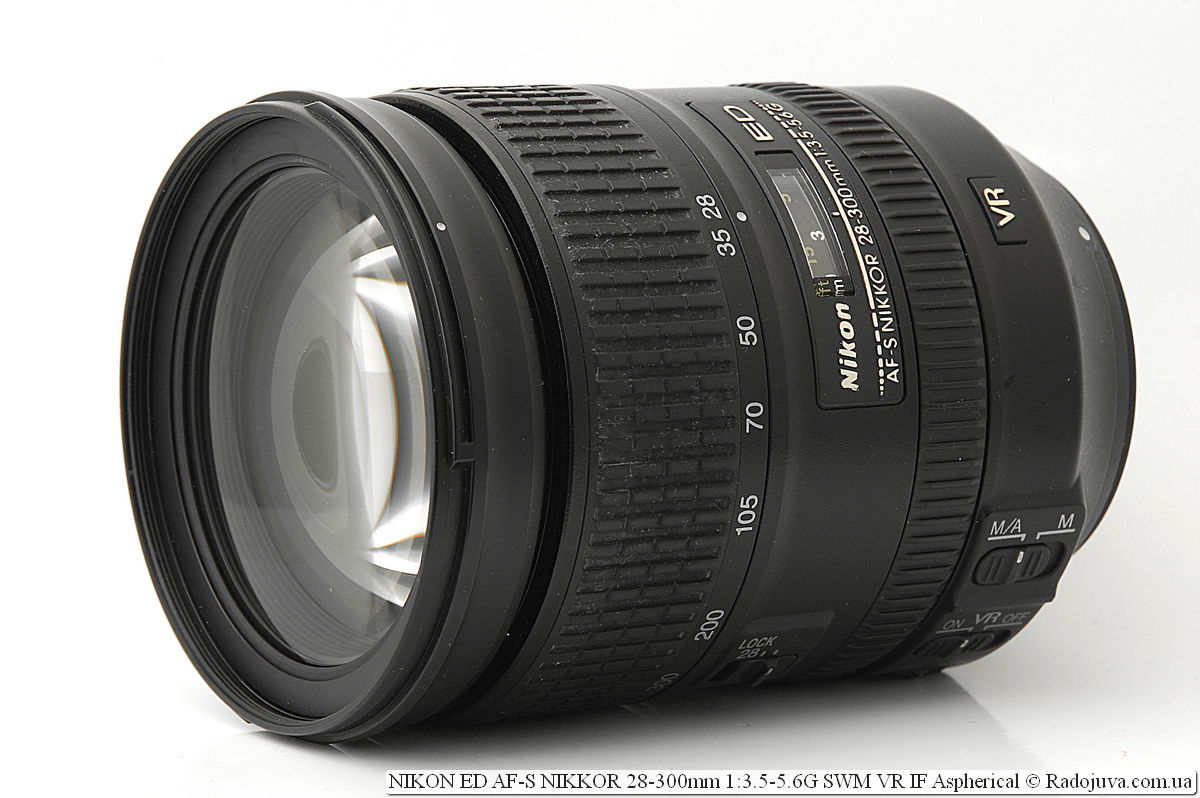
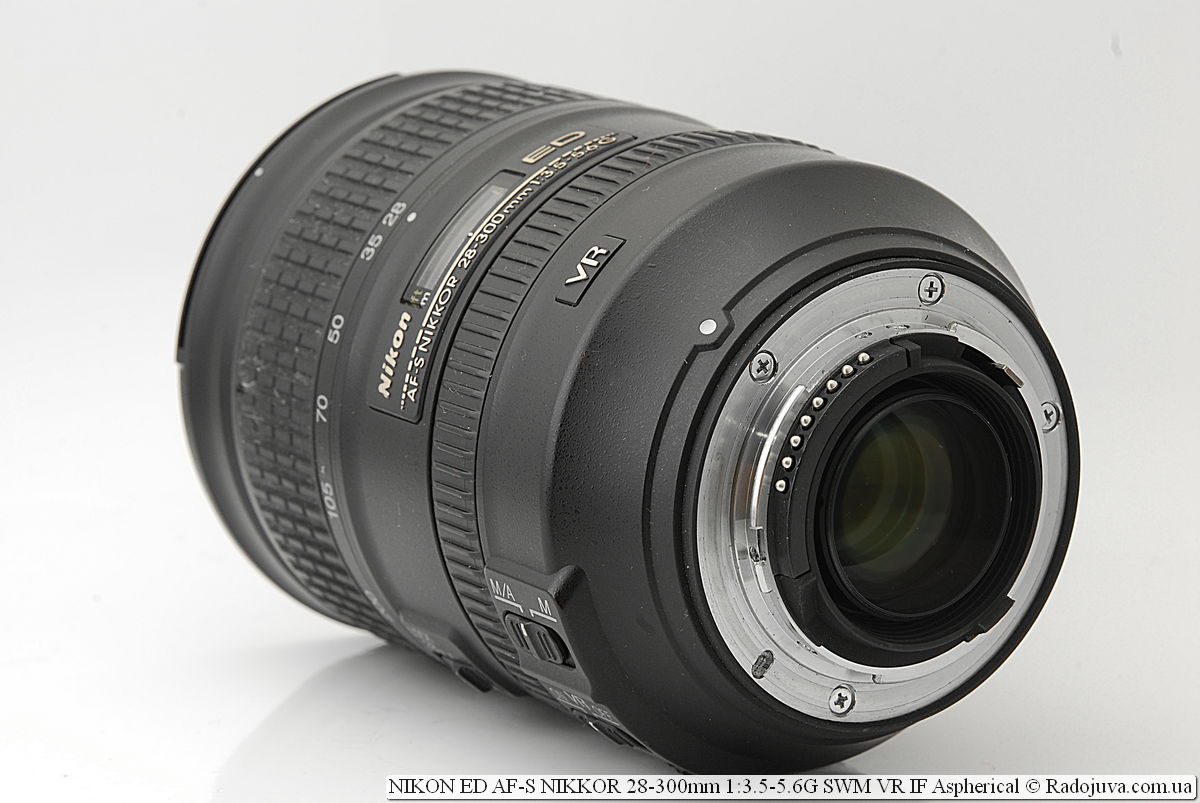

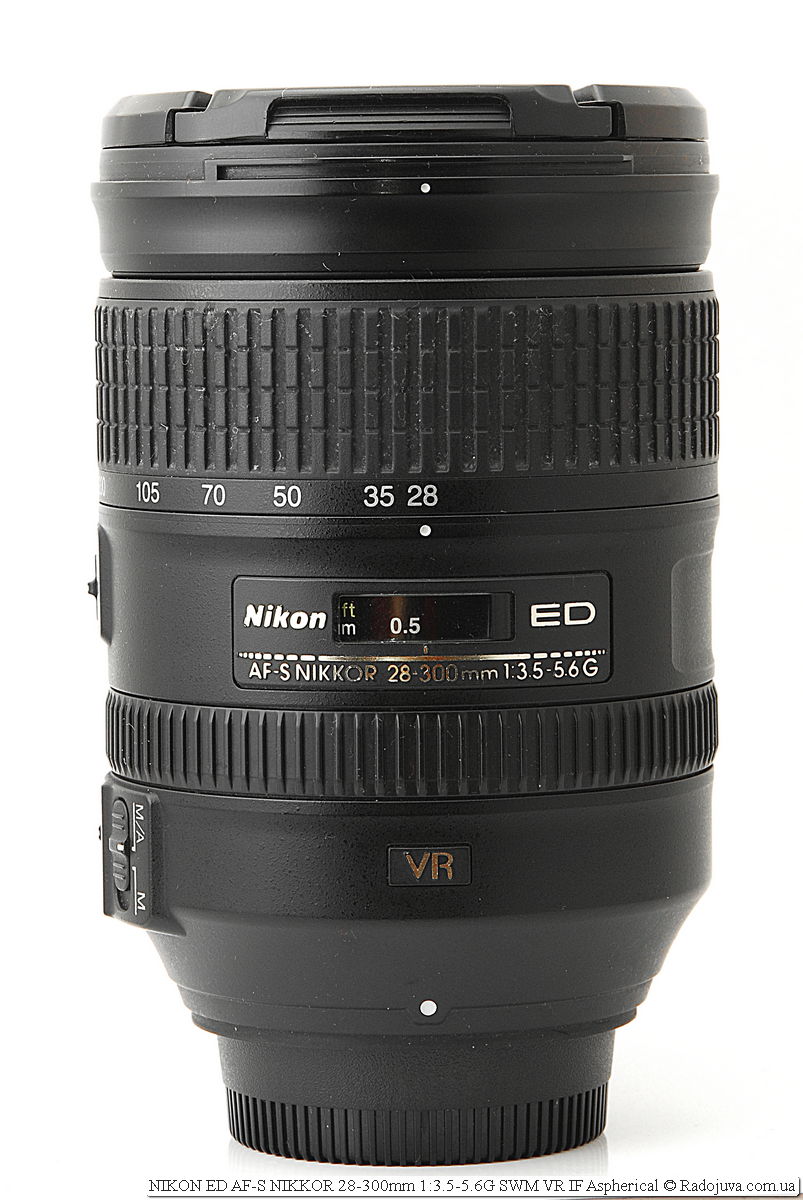
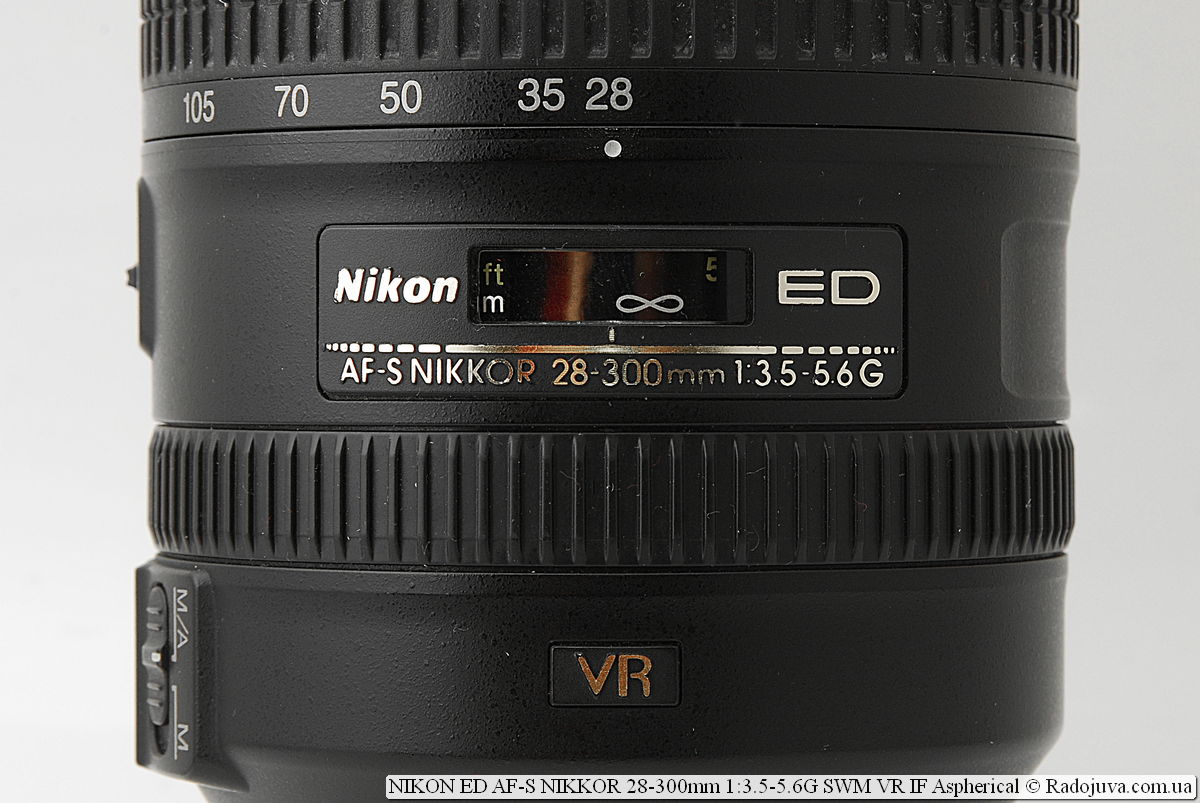
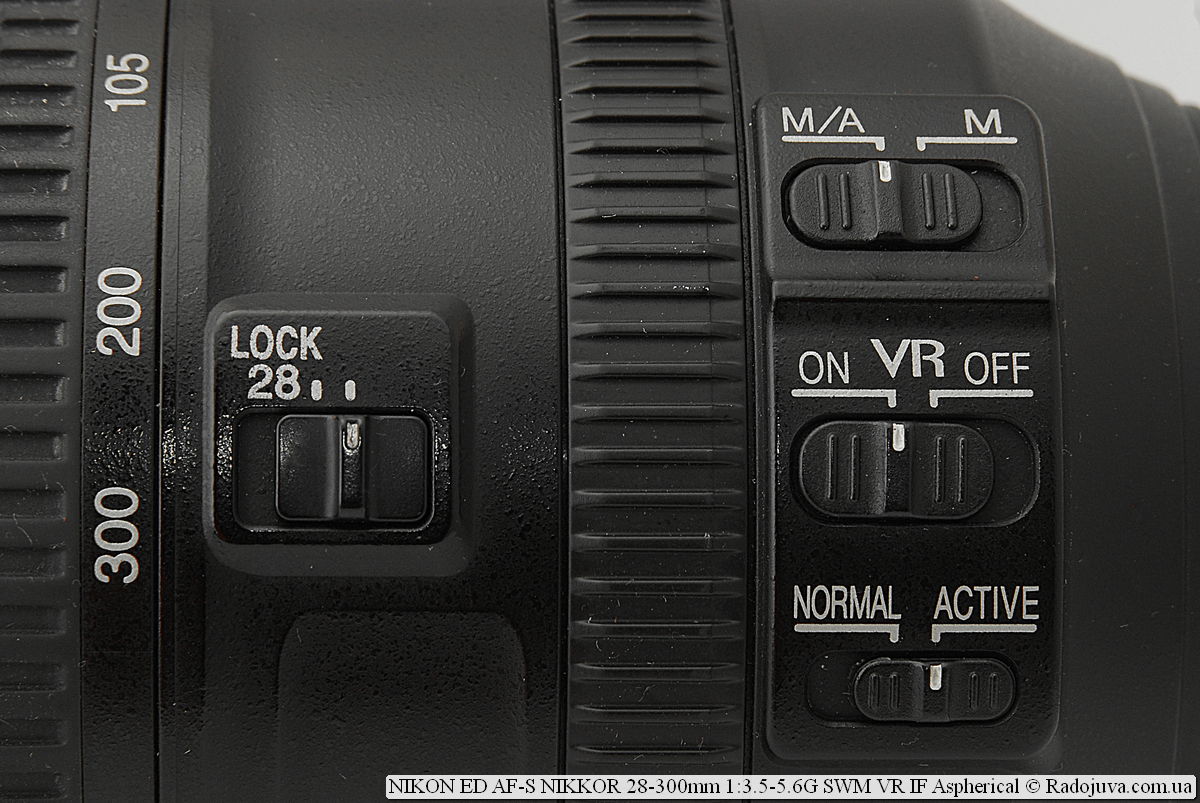
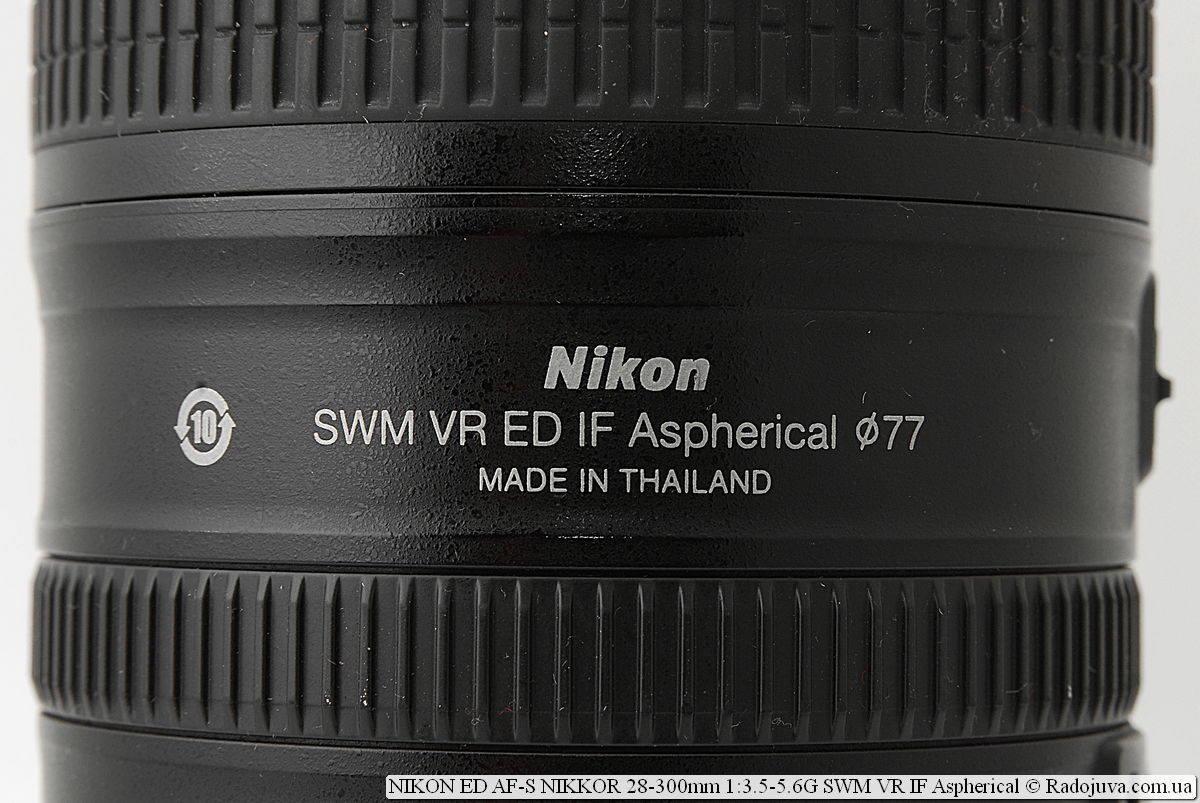
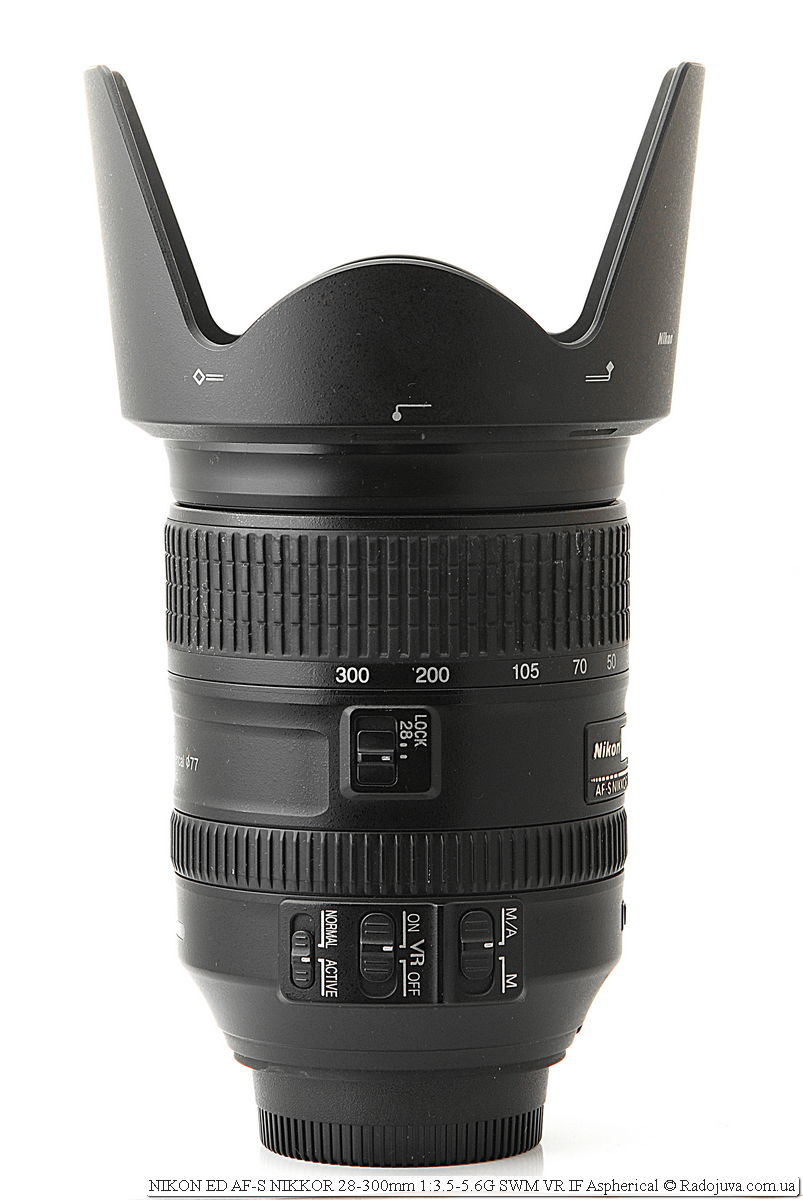
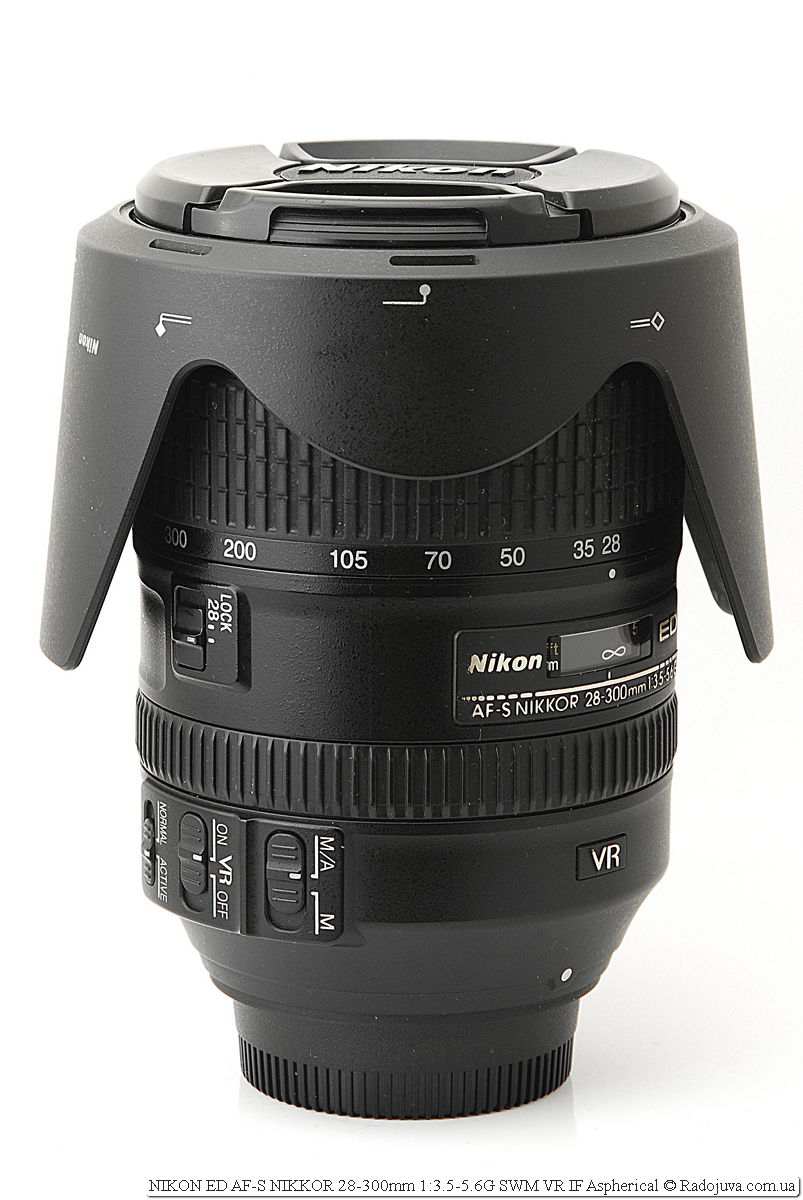














































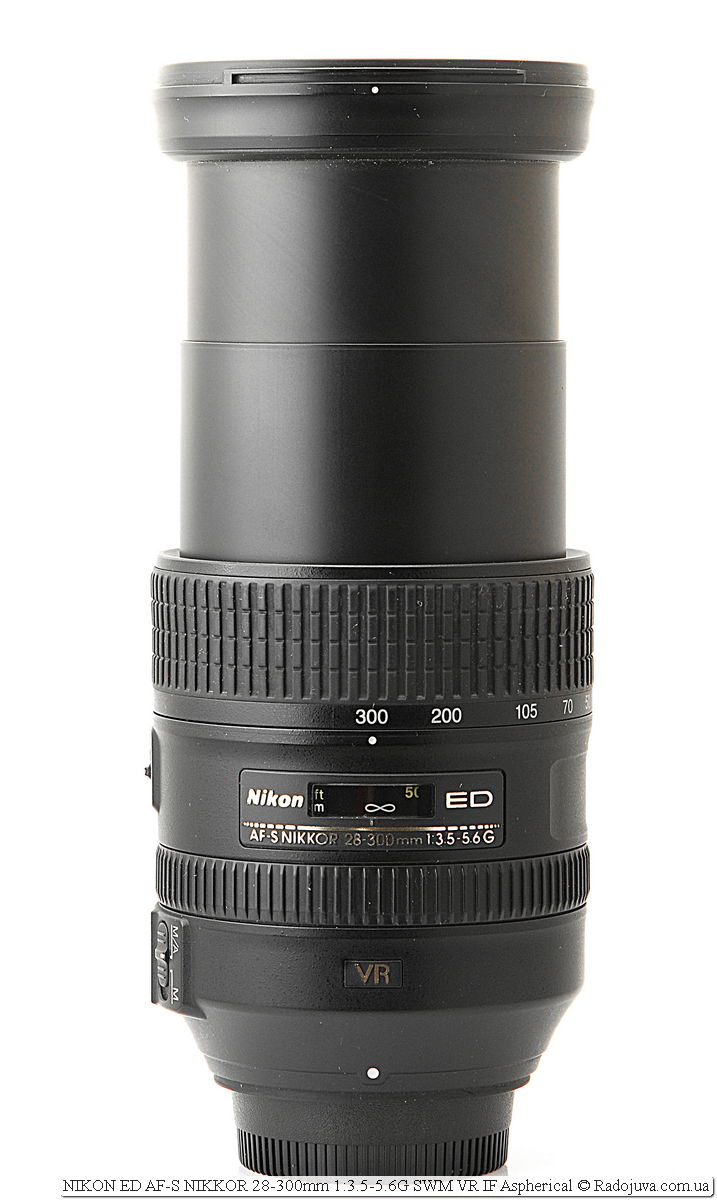
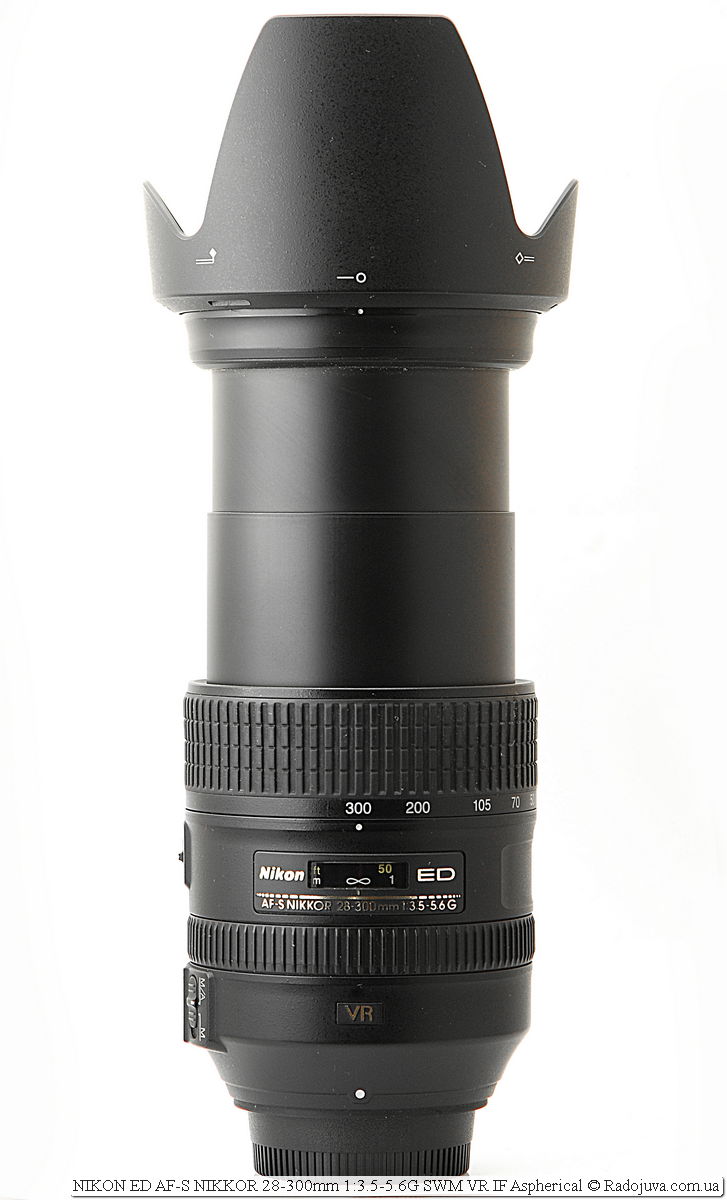

Personally, I preferred this lens (28-300) over Nikkor 70-300mm f / 4.5-5.6G ED-IF AF-S VR. The picture is almost indistinguishable, and the convenience is much greater (there is no limitation only by the telerange), and the luminosity is identical. I tried to do pairwise shots. In general, 70-300 chromatite is significantly larger and sharpness is head to head. As a result, I got rid of 70-300VR and left 28-300. These are the things, so no need to find fault with the superzum, it is very good, although the taste and color - the markers are different.
here about the sharpness of these lenses
http://www.the-digital-picture.com/Reviews/ISO-12233-Sample-Crops.aspx?Lens=734&Camera=614&Sample=0&FLI=4&API=1&LensComp=622&CameraComp=614&SampleComp=0&FLIComp=1&APIComp=1
It was here that I looked, when buying 70-300, to the already existing 28-300. But ... in my version it was not at all like that. They are head to head, almost indistinguishable in sharpness. After that, I realized that the resource you specified cannot always be used in real life. Either I came across bad 70-300s (by the way, I returned to 70-300 three times, that is, I bought and sold different copies three times), or I got a successful 28-300, but this is not at all like that. I specially shot the world at different focal points and made pairwise comparisons. Well, these two glasses do not differ in sharpness almost in any way. The focusing speed is yes, they differ, but the MDF of the 28-300 is much less than that of the 70-300. But all the same, it is not strongly felt, although 28-300 is slower.
Arakady, by the way, please add an article about Focus Breathing for this lens, but, as I see, many in their reviews complain that 300mm for this lens is a deception by the manufacturer, although nothing has been detected, just with such a wide spread of focus Focus Breathing is very pronounced.
I'm sorry, I overlooked. This is indicated as a separate block for you.
For me personally, this lens was a real discovery. I myself want to go hiking in the mountains, into the forest, anywhere, including many days. I used to refuse long-focus optics, because it is mostly heavy. Then I decided to buy myself a 70-200 f / 2.8 sigma. He dragged and puffed from weight and from the fact that you have to constantly throw, slowing down the progress of the group .. Now there are no such problems. 800 grams vs 1300 + 500 (24-85 f / 2.8-4). And as for the aperture, I can say that if they write 2.8, etc., this does not mean at all that a good sharp image is obtained on such a hole .. For example, for me, the sigma did not give a sharp picture at 2.8 (maybe, of course, an instance such got caught or hands are crooked). So I'm very pleased with the lens!
As for the weight, in my opinion, this is not serious. 800g is light weight. I have a macro lens, which I use now, more than half of all frames weigh almost the same. Well, nothing, hands have not dried up yet. Maybe, of course, this is not an option for a small puny girl, but such a weight should not bother an adult male too much. But the possibilities in terms of frame construction, in comparison with fixes, are almost limitless. For travel - a great option. For beginners, too. And the race for the pores, circles and mustache of the wife is from the evil one.
But how is the lens compared to the 70-300 in the television range? Or do not bother with versatility?
28-300 is not inferior to 70-300 anywhere, including in the television range, the only focusing speed is slightly slower, but not critical. Look at my comment just above Vitaly 10.06.2015/10/21 at XNUMX:XNUMX and the answers to it, there I reflected all the sensations from their comparison.
70-300 745 g
28-300 800 g
And where is it heavy?
Yuzayu 1,5 years:
1. Good color rendering and contrast, holds back light well.
2. Sharpness for zoom - very good, but there are "dips" at some focal lengths, it gives an adequate picture in portraits - soft in diffused lighting and hard in contrasting already on the open (if 5,6 can be considered open). From 250mm on the open - slightly swirls the background. The lens takes some getting used to.
3. Micro-contrast - super! It perfectly conveys the texture of fabric, hair, wool - but all this is only with sufficient illumination, underexposed by 1 stop - it seems to be nonsense, but everything is sharp (hair, forehead, nose, etc., everything that is sufficiently lit) - except for the eyes, which are soapy -that, the study is zero.
4. To shoot "little ones" in motion is torture, the focus often smears from 200mm - it simply does not have time to adjust to the tracking one, even with 3D focus. Focusing in the center - it smears the least, but still ... and the series does not always save. Sometimes a light front focus appears, and also mysteriously disappears, precisely at 200-300mm h.z .. Up to 200mm - everything is more or less good.
5. In general, it is a bit dark for reporting, apparently the autofocus sometimes “makes a fool” because of this, and if you are in no hurry, everything is ok. 24-120F4 vr - faster enough on the tracker.
6. It's strange that XNUMXx zoom can shoot like that! For travel - excellent, as a station wagon - very good, for staged - good, for weddings and sports - very doubtful. With flash - super, for rooms with natural light - so-so.
7. With him you need patience and knowledge of his capabilities, and many newbies do not want to fight for the frame - and sell completely new ones for only 15-20 tyr, shouting about "soap", etc. and so on.
8. I will not sell, for sure.
Oh, men ... Fir-trees, sticks, 28-300 is hard for them ... I have 28-300 more than a year, I'm happy and love him no less than Zeiss poltishka. But the sigma 50-500, which weighs 2 kg (!!!), is certainly not for modern photographers. Only for photographers :)))) I use it for several months. Heavy and dark. Probably I would not advise you to buy. Although the ducks on the lake get to the reflection of a blade of grass in the eye :)
Selling such a lens perfect condition
http://dnepropetrovsk.dnp.olx.ua/obyavlenie/nikon-nikkor-af-s-28-300mm-f-3-5-5-6g-ed-vr-IDfve6C.html
The lens is quite good for everyday on ff.
For serious work, I do not recommend real problems with focusing speed in low-light situations. Yes, and so on the whole, the focus speed is not very good.
Sharpness is. Arranges.
And I like it Pts ... I played enough with many ... and Now 24-70 lies idle ... Yes, the drawing sometimes fails, but I like all one thing ... For every day)))
And here is the frame
Or this one ... What's wrong ???
Overfotoshop.
Well, since they asked ... not with a lens
The lack of a sane composition, a wild patient of some color and a screaming violent vignette.
worse and never happens. perhaps you think the first 2 photos are good because the people you love are there taken) the third and so on
I have been using it for a long time, mainly in traveling paired with the D700. Do not judge strictly, examples of photos here: https://fotki.yandex.ru/next/users/tohep/album/33787/view/635751
Waiting for your comments.
What I don't like is endless distortions, the focus is not fast, but acceptable. Colors also do not always suit. For some reason, now I wanted something more.
In general, 28-300 is considered one of the best megazums. “Endless distortions” are inevitable here. As for color, it's more of a gem in your D700 - its matrix influences color much more than the lens does.
Question to the author. You can date information about the company updating this lens. Or maybe something new is being developed? Just mercantile expectations about the cheapening of the old model.
I think you should not expect it.
The monster is significantly smaller than even the 70-300, a very compact lens for such characteristics.
Compact as a shirik, lightweight compared to the same from canon and with a decent picture for 11x zoom.
To zoom is not bad.
I had one. I took it with me on a couple of trips. The focal length range is convenient. But there is no picture quality, and to carry such crap together with the D800 is not respecting either yourself or the D800. Plus, I can't stand trunks. Therefore, as soon as a willing person was found (thank you, Lord), he sold it. Then I chose 70-200 for a while (Nikon or Tamron). As a result, I took a Tamron 70-200 f / 2.8 Di VC (honestly, it's not about the money) - if you really carry something on yourself, then at least it's clear why. And for trips fujik should take the type x-t2, x-t1 or their younger non-professional brothers in my opinion. Or maybe even move to fujifilm.
Then why oh why on micra, Oli OMD-EM1-mkII? 800 g complete with 14-140, 5 stops of stub, on slow and non-responsive objects without a miss, plus video. BUT ... everything will be fine with weight, but as soon as you want quality, glasses of the series about 12-40 and 40-150, which are 2,8. At the same time, the weight of the system will be comparable, the quality of the picture in terms of sharpness, detailing is at the level of 28-300, the range loses to the Dynamo, and if you are not a fan of video then ask yourself a question - do you need it? Fuj in this sense is generally a brave system, with all their little things
Good afternoon!
Aren't you familiar with the Nikon 18-300mm f / 3.5-5.6G ED AF-S VR DX lens?
How much worse is it described in your article?
Perhaps this is another question, but I did not find information on this lens model on your site. As I understand it, he has only less near focus and he is DX.
I have a Nikon D90. And it seems to me that there is no point in overpaying for a full-format lens. Do not help with advice?
Thank you!
18-300 lens for DX type cameras, such as the D90. At the same time there are two models 18-300 3.5-5.6 and 18-300 3.5-6.3. The latter is simpler. For crop, you definitely need to look at 18-300.
Have you had any experience with a simpler lens (18-300 3.5-6.3)? How bad is it?) I looked at its description: it is quite light and short. It’s not clear how it removes.
I use the camera mainly when traveling. I have a fix, a whale lens and a telephoto. I recently realized that I’m practically not using a TV set. Although he gives pictures an order of magnitude better than whale. Hemorrhoids carry it with you in a bag). I rent everything on a whale.
I really don’t like it, and sometimes its range is not enough, but when you walk for several hours, I have no other alternative.
Does it make sense to replace the whale + telephoto camera for travel photos with the “Nikon 18-300mm f / 3.5-6.3G ED AF-S VR DX”?
There was no experience. There is a point, but if you are satisfied with two lenses, then you can leave the situation like that.
Thank you)
And what is worse on the crop will be 28-300?
There will be no wide angle on the crop.
EGF will be 42-450.
I like the lens. I use it as a standard one with D700 - I have no complaints about the focusing speed. I shoot hockey, football, concerts with it - 9 out of 10 shots are in focus. The quality of the photos is also quite satisfactory.
Tell me how to behave on the crop? Can I get it for the D5500?
I want to change 24-85mm to 28-300mm. Tell me, is it worth it?
In case you missed it, Arkady said in this review: “But the Nikon 28-300 / 3.5-5.6G is still too heavy to be a versatile lens for every day. It's better to have a lighter and more compact kit Nikon AF-S Nikkor 24-85mm 1: 3.5-4.5G ED VR SWM IF Aspherical than to rush with this monster. ”
In addition, on a crop, in my opinion, it is not at all justified (in addition, heavy). Like 24-85, there is no wide angle. At one time, I took Tamron 28-75 / 2,8 based on portrait focus and a possible transition to FF, so I could not cling to it as a universal one for shooting “everything” - a wide angle was not enough. On the crop, there is a good station wagon 18-105, if necessary, not light.
I had 70-300 and 24-85 at the same time, the angle seems to be enough, the lens change is more annoying than the weight. While I have sold only 70-300, I want to take something universal instead of them. For portraits there is 50 / 1.8. So it’s interesting how it behaves on a crop of 28-300 by image quality or a closer look at 18-200G || ?
Take 18-140 (105). Do not expect miracles from them - the usual travel zoom with a boring picture. But versatile. 18-300 is even more versatile, but heavier, more expensive, and optically worse at the edges of the range
What a wrong approach, 24-85 is better for every day. Does this mean that for every day the range of 85-300 is not needed? Who decided this? And if you need one? No, then equivalent systems are 24-85 + 70-300 versus 28-300, and I’ll look at the one who chooses two glasses instead of one with the same quality and greater total weight and inconvenience with overdrive.
Looking for what and what you will shoot. I have 28-300-practically do not take off. Use - report in all manifestations. Alas, there is not enough wide angle and aperture). The noise on the Nikon D750 with this glass is already noticeable at 4000 ISO.
and a person has a crop ...
There has been this miracle for five years. I shoot mostly with fixes, but sometimes I screw this pipe and under good shooting conditions all the squirrels, my ducks))). I think its main advantage is versatility, the main disadvantage is dark. About autofocus I confirm misses happen, but I'm so used to constant refocusing that I don't notice it at all. And landscapes are the golden mean. As a result, I do not regret that I bought it back in 2014. For the money that is now being sold in my life I would not buy it.
I, unaffected by those who, at the same time, era of dinonosaur-mirror cameras do not use new, lightweight, non-mirror systems, in the ninth summer of 2019 there are “oldies”, who can buy good old mirrors for home brown.
I didn’t think so, in the article Arkady recommending Nikon AF-S Nikkor 24-85 for a “close-angle” camera, but I’m absolutely right, full-frame option for cameras .. I’ll add to the list of current Nikon AF-S S Nikkor 18-70, like є at Arkady on the lookout also))
Wonderful vib_r for crop-var_ant_v on leather day!)
Surely, changing the Nikon AF-S Nikkor 18-55 to the “floppy” Nikon AF-S Nikkor 18-70 is not a strong sense ... that, if you take the camera, and VIBRATE the camera, then I recommend it!
And vi, @ Arkadiy, what do you say?
Everyone decides for himself. For beginners, 24-85 (VR or normal) under the full frame just right